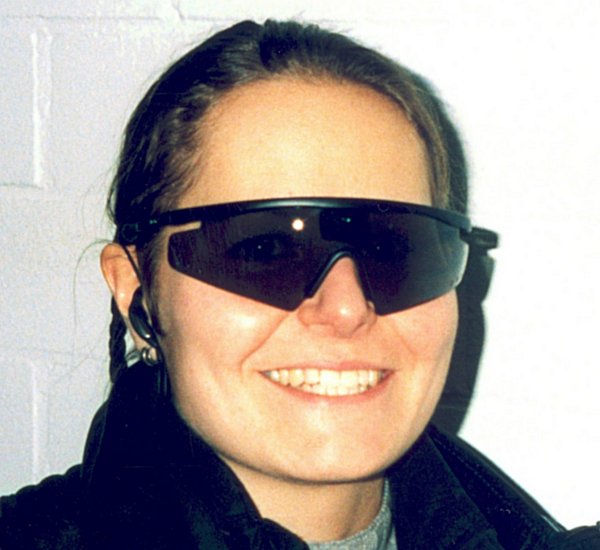« The vOICe Home Page
« The vOICe for Windows
This web page is obsolete and will no longer be maintained.
Augmented reality glasses with a camera allow for real-time image processing as needed
for generating augmented reality (AR) overlays that are not just based on GPS location sensors
and orientation sensors, but that really take the user's visual environment into account.
Camera glasses also allow for unobtrusive indoor mapping, analogous to Google Streetview
and Microsoft Streetside Photos, the latter explored by Microsoft for Bing Maps in combination
with its real-time Photosynth image-stitching technology.
 Apart from AR and mapping applications for the sighted masses, this then also enables providing
live visual input to the blind for augmented vision purposes, be it through corresponding auditory
stimulation (The vOICe) or tactile stimulation, or through implanted
electrodes as with retinal implants and cortical implants.
Apart from AR and mapping applications for the sighted masses, this then also enables providing
live visual input to the blind for augmented vision purposes, be it through corresponding auditory
stimulation (The vOICe) or tactile stimulation, or through implanted
electrodes as with retinal implants and cortical implants.
The vOICe vision technology for the blind is in principle best used with unobtrusive
video sunglasses - dark glasses featuring a hidden camera, also known as spy glasses -
that can be connected directly to a PC's USB port for both the video signal and the camera's
power supply (just like one would use a regular plug-and-play USB webcam or PC camera),
or that use a Bluetooth wireless connection and a battery in the glasses. A suitable viewing
angle is on the order of 90-135 degrees horizontal. Dark glasses will often be preferred
over uncolored glasses by those blind users whose eye condition affects appearance. Low
cost is important too, while options for stereo vision through
a dual camera setup hidden inside sunglasses would be desirable as long as depth imaging
sensors prove too costly, power consuming or inadequate under broad daylight conditions.
The legs of the glasses in the assembly shown on this page also contain tiny hidden
microphones for giving speech commands.
Depending on the choice of image sensor, the same wearable setup could also be used
for night vision (with light amplification), infrared vision (e.g., thermal imaging
using microbolometer infrared imaging arrays, for easier detection of other people
from their typically high temperature contrast), ultraviolet vision, UWB radar imaging,
or other special uses, including sensor fusion. Accelerometers may be added for easier
or more accurate motion detection. For third-party vendors of various components for
wearable and fully immersive use of The vOICe, see the
third-party suppliers page.
Early solutions involved use of sunglasses that contain a tiny analog covert camera
or surveillance camera with the inconvenience of a separate battery pack, USB video
capture device, and extra (fragile) wires, although there existed possibilities for
easy assembly of a convenient and affordable USB power supply for video sunglasses.
Depending on the type of video sunglasses, one had to change settings of the video
capture device for PAL versus NTSC, and composite video versus S-video. The older
information about various options for analog video sunglasses and supporting hardware
has now been removed from this page as it is considered mostly obsolete with the
advent of affordable USB camera glasses and similar devices:
|
In terms of affordable and convenient solutions for blind starters there now exist
options to easily create a wearable setup using commercially available
USB camera sunglasses, in combination with
a stereo audio headset.
No need for a separate video capture device and battery pack in these cases!
|
Copyright © 1996 - 2025 Peter B.L. Meijer
 Apart from AR and mapping applications for the sighted masses, this then also enables providing
live visual input to the blind for augmented vision purposes, be it through corresponding auditory
stimulation (The vOICe) or tactile stimulation, or through implanted
electrodes as with retinal implants and cortical implants.
Apart from AR and mapping applications for the sighted masses, this then also enables providing
live visual input to the blind for augmented vision purposes, be it through corresponding auditory
stimulation (The vOICe) or tactile stimulation, or through implanted
electrodes as with retinal implants and cortical implants.